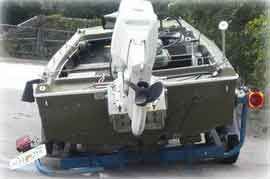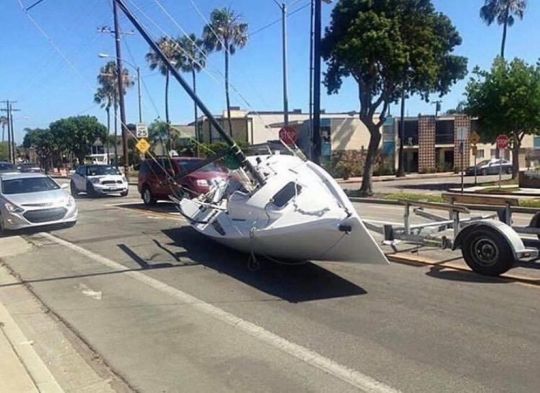Boat Trailer Maintenance
General Maintenance
The coming of cold, wet and wintry days is the perfect time to thoroughly inspect and do some maintenance on your boat trailer. Just because your boat is your pride and joy, don’t forget what gets it to the waters edge and not sitting on the side of the road with some major fault.

Obvious items include checking tyre pressures, and look for signs of rust, wear and damage, checking and cleaning lights and reflectors regularly, and lubricating the tow coupling, winch bushes, gears and brake mechanisms.
Salt water and salt laden air is a trailer’s biggest enemy, and even though your trailer may be galvanised, corrosion can still occur. Always wash your trailer after exposure to salt water and salt laden wind.
Salt deposits will shorten the life of the zinc coating and your trailer. The galvanising on your trailer is the sacrificial coating to the steel it protects. The galvanising is made up of 99.5% zinc and acts in the same way as an anode attached to your outboard engine. The coating slowly degenerates with an electrolyte such as saltwater and the galvanising tends to dull off after a period of time. If left unwashed, the zinc coating will eventually disappear.
To prevent premature corrosion, you should wash your trailer on a regular basis with a solution of warm water and detergent. The inside of the chassis and cross members can be cleaned out by putting a hose into the drain holes and flushing out. One of the best protective measures is to immerse the trailer in fresh water like a river or lake, after it has been in saltwater, though of course this is not always practical.
Springs
Maintenance of boat trailer leaf springs can be more difficult and while washing them down after a day at sea, most of the damage occurs after launching and when the trailer is left in the sun while you are out boating. Periodic washing down, drying and them spraying the leaf springs with a proprietary penetrating oil like CRC or rust inhibitor will assist in prolonging there life.
Brakes
Because trailer brakes suffer much greater wear than the tow vehicles brakes, and because they are regularly immersed in salt water, maintenance is critical, especially if the trailer is to be stored for a period of time. Again, they must be hosed down thoroughly after salt water immersion, and is best to give them a full service at least once a year.
Problems arise when moisture is trapped in behind the rubber boots on the caliper pistons and the caliper slide pins. Check the pads and slide pins for wear or damage and it’s also important to note that the caliper should move freely by hand. While there are no greasing points on the calipers, periodic lubrication of the two slide pins is recommended. This is best done when replacing the brake pads.
It is also advisable to renew the brake fluid when servicing the calipers as the fluid can become contaminated with moisture and cause internal corrosion and seizure of the brake components.
Wheel Bearings
Wheel bearings are a crucial part of your trailer maintenance. They should be checked and regreased at least twice a year.
To check your wheel bearings, jack up the trailer and spin the wheels, checking for noise, vibration and excessive play (side to side and top to bottom). Any of these symptoms suggest worn bearings and could cause you a disastrous day sitting on the side of the road instead of out on the sea or lake.
Removing the dust caps and looking and smelling the condition of the grease will also give you a good idea if the bearings have been contaminated with water or cooked due to lack of grease. Never use water soluble grease to repack the bearings.
If the bearings are worn, they need to be replaced and is within the capacity of most home handypersons.
Wheel Bearing replacement
Loosen the wheel nuts and jack up the trailer so the wheel clears the ground. Chock the trailer for safety’s sake with axle stands, never put your full trust in your jack. Remove the wheel nuts and wheel, and use a soft-faced hammer to gently tap the dust cap off.
Locate and remove the split pin from the castle nut. Remove the castle nut and washer, grab the hub and pull off the axle. Remove the seal and seal retaining washer.
The bearing is made up of two parts – the cone with its tapered rollers and the cup which supports the cone. Before going any further with your work, clean the cones and slide them onto their respective positions on the axle. If the bearing slides on the axle sloppily and does not sit firmly, the axle could be worn and need replacing. Contact your trailer manufacturer if this is the case

Remove the seal wear ring from the back of the hub with a screwdriver and clean out the inside of the hug with solvent and clean rags.
To remove the cups from the hub, tap out from the opposite ends with a pin punch and hammer taking care not to damage the bore of the hub. Once the bearing cups have been removed, clean and check hub for damage. Fit the new cups with a brass or mild steel drift and hammer, never hit any bearing part with a hammer or hardened steel as the bearing being very hard, can crack and cause bodily harm when it shatters.
Pack the new cones thoroughly with grease and place a good quantity of grease in the hub cavity. Fit the back end bearing, tap on the seal wear ring and before sliding the hub onto the axle, fit the seal retaining ring and seal to the axle. Slide hub firmly onto the axle and fit the front end bearing cone.
Fit the washer and castle nut. Tighten the castle nut until a slight binding is felt. Back off until the hub runs free but without any free play. Fit new split pin through the castle nut and axle, smear a gob of grease around the inside of the dust cap and tap onto the hub.